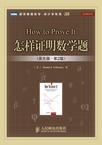怎样证明数学题
2009-07
人民邮电出版社
Daniel J. Velleman
384
无
Students of mathematics and computer science often have trouble the first time theyre asked to work seriously with mathematical proofs, because they dont know the "rules of the game." What is expected of you if you are asked to prove something? What distinguishes a correct proof from an incorrect one? This book is intended to help students learn the answers to these questions by spelling out the underlying principles involved in the construction of proofs. Many students get their first exposure to mathematical proofs in a high school course on geometry. Unfortunately, students in high school geometry are usually taught to think of a proof asia numbered list of statements and reasons, a view of proofs that is too restrictive to be very useful. There is a parallel with computer science here that can be instructive. Early programming languages encouraged a similar restrictive view of computer programs as numbered lists of instructions. Now computer scientists have moved away from such languages and teach programming by using languages that encourage an approach called "structured programming." The discussion of proofs in this book is inspired by the belief that many of the considerations that have led computer scientists to embrace the structured approach to programming apply to proof-writing as well. You might say that this book teaches "structured proving."
本书介绍了数学证明的基本要点,内容通俗而不失严谨,可以帮助高中以上程度的学生熟悉数学语言,迈入数学殿堂。新版添加了200多个练习题,附录中给出部分练习的答案或提示。 本书适用于任何对逻辑和证明感兴趣的人,数学、计算机科学、哲学、语言学专业的读者都可以从中获益匪浅。
Daniel J. Velleman 艾姆赫斯特(Amherst)学院数学与计算机科学系教授,《美国数学月刊》主编。另著有 Which Way Did The Bicycle Go和Philosophies of Mathematics。他的研究兴趣广泛,主攻数理逻辑,在组合、拓扑、分析、数学方法论、量子力学等多个领域都发表了大量论文。
Introduction1 Sentential Logic 1.1 Deductive Reasoning and Logical Connectives 1.2 Truth Tables 1.3 Variables and Sets 1.4 Operations on Sets 1.5 The Conditional and Biconditional Connectives2 Quantificational Logic 2.1 Quantifiers 2.2 Equivalences Involving Quantifiers 2.3 More Operations on Sets3 Proofs 3.1 Proof Strategies 3.2 Proofs Involving Negations and Conditionals 3.3 Proofs Involving Quantifiers 3.4 Proofs Involving Conjunctions and Biconditionals 3.5 Proofs Involving Disjunctions 3.6 Existence and Uniqueness Proofs 3.7 More Examples of Proofs4 Relations 4.1 Ordered Pairs and Cartesian Products 4.2 Relations 4.3 More About Relations 4.4 Ordering Relations 4.5 Closures 4.6 Equivalence Relations5 Functions 5.1 Functions 5.2 One-to-one and Onto 5.3 Inverses of Functions 5.4 Images and Inverse Images: A Research Project6 Mathematical Induction 6.1 Proof by Mathematical Induction 6.2 More Examples 6.3 Recursion 6.4 Strong Induction 6.5 Closures Again7 Infinite Sets 7.1 Equinumerous Sets 7.2 Countable and Uncountable Sets 7.3 The Cantor-Schr6der-Bernstein TheoremAppendix 1: Solutions to Selected ExercisesAppendix 2: Proof DesignerSuggestions for Further ReadingSummary of Proof TechniquesIndex
1.1. Deductive Reasoning and Logical Connectives As we saw in the introduction, proofs play a central role in mathematics, and deductive reasoning is the foundation on which proofs are based. Therefore, we begin our study of mathematical reasoning and proofs by examining how deductive reasoning works. Example 1.1.1. Here are three examples of deductive reasoning: 1. It will either rain or snow tomorrow. Its too warm for snow. Therefore, it will rain. 2. If today is Sunday, then I dont have to go to work today. Today is Sunday. Therefore, I dont have to go to work today. 3. I will go to work either tomorrow or today. Im going to stay home today. Therefore, I will go to work tomorrow. In each case, we have arrived at a conclusion from the assumption that some other statements, called premises, are true. For example, the premises in argument 3 are the statements "I will go to work either tomorrow or today" and "Im going to stay home today." The conclusion is "I will go to work tomorrow," and it seems to be forced on us somehow by the premises.
“本书行文简洁,通俗易懂……习题如此丰富,而且难度各异,层次错落有致……强烈推荐!” —— MAA Reviews “本书介绍了数学证明的基本要点,非常有价值。” —— SIAM Review “非常好的一本书!全面而清晰的解释、丰富的例子、附有解答的习题,使它出类拔萃,但凡你要写证明,就应该选择它, 无论是自学还是课堂学习。” ——Brent Smith, SIGACT News
《怎样证明数学题(英文版·第2版)》深受好评,众多读者受益于《怎样证明数学题(英文版·第2版)》,学会了如何证明数学题。无论你来自什么背景,是从事计算机科学还是哲学、语言学,只要你对逻辑和证明感兴趣,就应该仔细研读这《怎样证明数学题(英文版·第2版)》。研究数学的师生更是不可错过《怎样证明数学题(英文版·第2版)》。面对证明题,你是否一脸茫然、不知所措呢?是不是迫切需要一个人来教你写证明呢?《怎样证明数学题(英文版·第2版)》将带给你惊喜,教你一步一步地构造证明的框架。阅读《怎样证明数学题(英文版·第2版)》不需要太多的知识背景,只需要你具有高中数学基础。为了让你熟悉数学语言,作者从构建证明的基础——逻辑和集合论的基本概念讲起。丰富的示例,大量的习题,足以让你在它的指导下掌握证明的“游戏规则”。新版添加了200多个练习题,并且附录中给出部分练习的答案或提示。其中一些习题可以用计算机软件Proof Designer来解答,作者还在附录中介绍了Proof Designer软件。

无
有兴趣的翻一翻
还不错。。。。。。
It's really good since you can't find such books written by Chinese people who are said to be one of the smartest group of people on the earth.But who knows?
个人觉得完全没什么用。纯粹logic的一些东西。